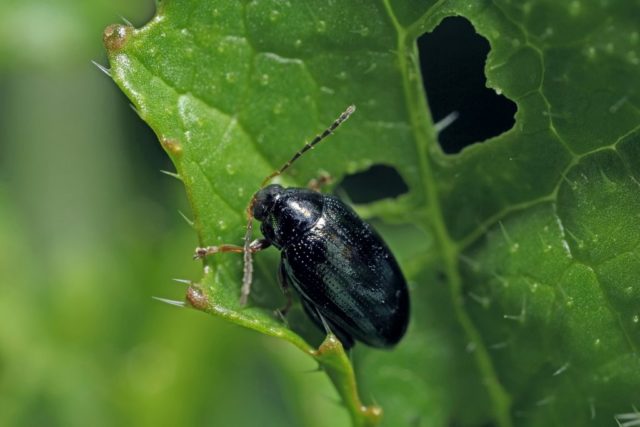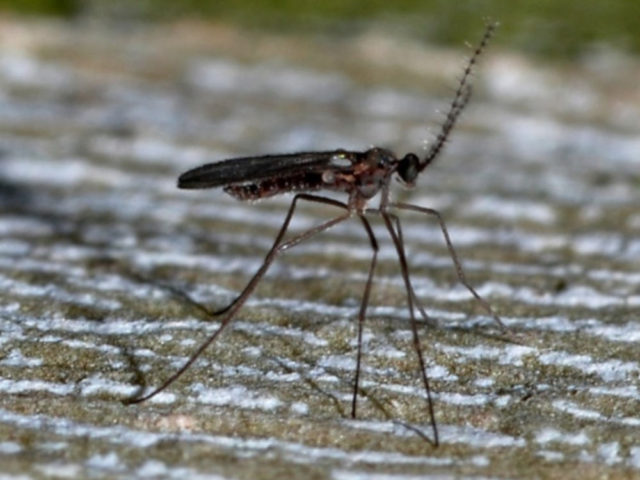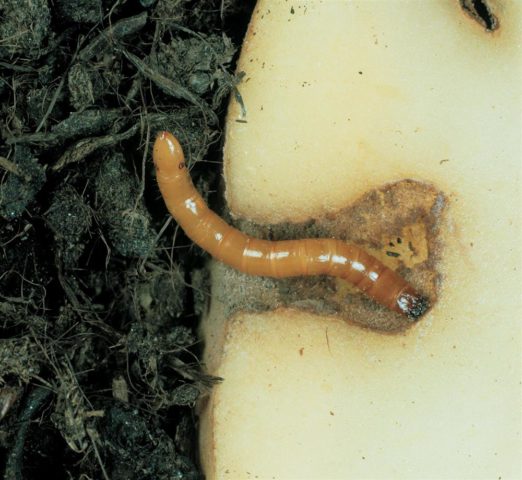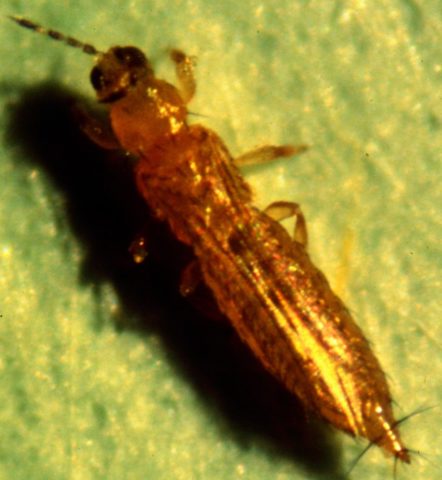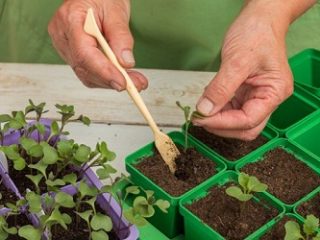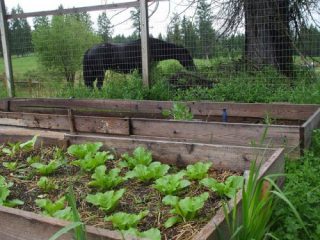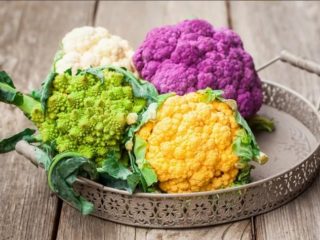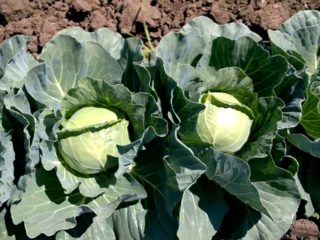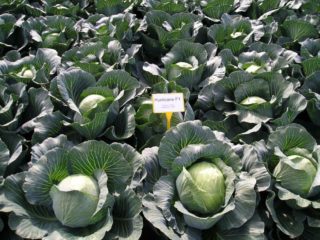Content
Growing and caring for kohlrabi outdoors is not difficult, especially if you have experience with other varieties of cabbage. It is important to choose the right place for the culture, to decide on the planting method and suitable timing. Outdoor kohlrabi care should be comprehensive.
How kohlrabi grows
The ancient Romans began to cultivate kohlrabi. It attracts with its rich chemical composition and is a valuable dietary product.
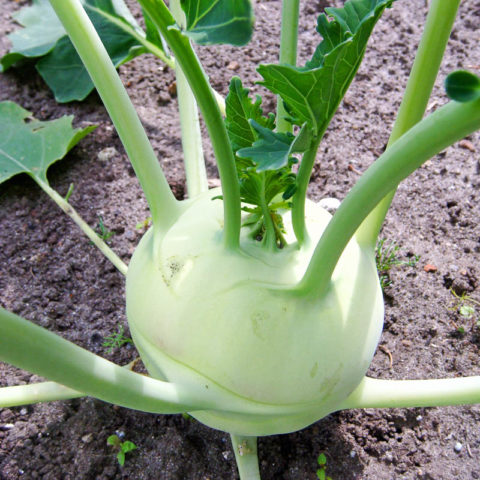
The thickened stem fruit outwardly resembles a turnip or rutabaga, this gave the name to the culture - translated from German it means "cabbage-turnip"
Kohlrabi has a developed root system with a thin, but long taproot with dense branching from it. It is located at a depth of 0.25-0.3 m and evenly diverges in different directions by about 0.6 m.The main root with branches can go deep up to 2.5 m.
When a 7-8 true leaf appears in kohlrabi, the stems are clearly thickened. Later, they are formed simultaneously with the growth of leaves. The shape of the stalk depends on the variety; round and round-flat species have the best taste. In later varieties, the leaves are larger, and their number is greater.
The stems are covered with a thick peel. The flesh is firm and fleshy, but juicy and sweet. There are many vessels in the core, therefore the stem grows coarser as it ripens.
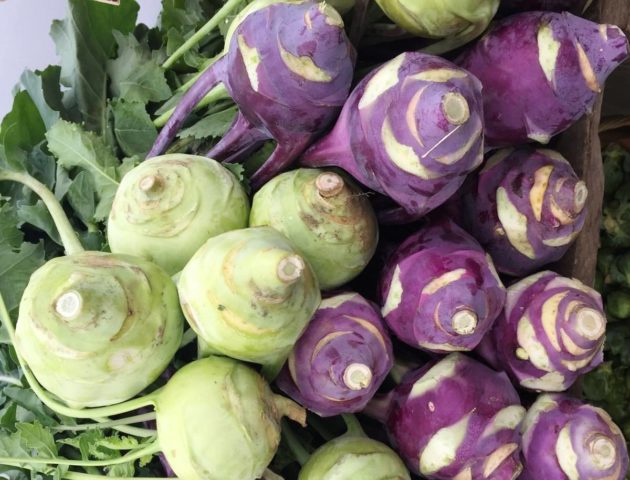
Depending on the variety, the peel can be green or purple.
Where does kohlrabi grow
Growing kohlrabi outdoors is successful in all regions. She prefers a daytime temperature of 15-18 ° C and a nighttime temperature of 8-10 ° C.
Kohlrabi is a cold-resistant crop. In a drought, it can extract moisture in the depths of the soil, but its lack is fraught with low quality of stem crops.
For the successful cultivation of kohlrabi, the site must meet the following requirements:
- enough light - when shading, the fruits are formed longer, the yield suffers;
- southern or southeastern slopes are preferred;
- long daylight hours, in such conditions leaves grow faster and stems are formed;
- loose loamy soil enriched with organic matter;
- the acidity of the earth is neutral or slightly alkaline, the optimal indicator is 6.5-4.4 pH (5.5 is allowed);
- in the open field, it is better to plant a culture after legumes, perennial grasses, potatoes, tomatoes, carrots, pumpkins, zucchini;
- any member of the Cruciferous (Cabbage) family is a bad predecessor.
A plot for growing kohlrabi in the open field must be prepared in the fall. Digging depth - shovel bayonet. It is obligatory to add the following elements for 1 m²:
- wood ash 1 cup;
- urea 1 tsp;
- organic 3-4 kg;
- superphosphate 1 tbsp. l.
How much kohlrabi cabbage grows
Almost all varieties of kohlrabi are early ripening. In the open field, maturation takes 65-75 days. In this case, harvesting can start earlier.
When to plant kohlrabi cabbage
Planting dates depend on the chosen method. If you plant seeds on the site, then sowing work can be planned for early May.
Seedlings begin to grow from mid-March, and they are moved to the garden in early May. You can move the dates or plant the next batch at the beginning of May.
Planting can be continued until the end of June. Autumn frosts are not terrible for the plant. The optimal interval between crops is 2 weeks.
How to grow kohlrabi
You can grow kohlrabi by sowing seeds in the open field or through seedlings. The first option is more suitable for varieties with medium and late ripening. Seeds germinate outdoors at temperatures between 15-18 ° C. It is better to grow early and hybrid kohlrabi in the country through seedlings.
How to grow kohlrabi cabbage seedlings
It is better to grow seedlings in a special substrate. The soil should be light and loose and contain peat. It is better to mix it in equal parts with turf and humus.
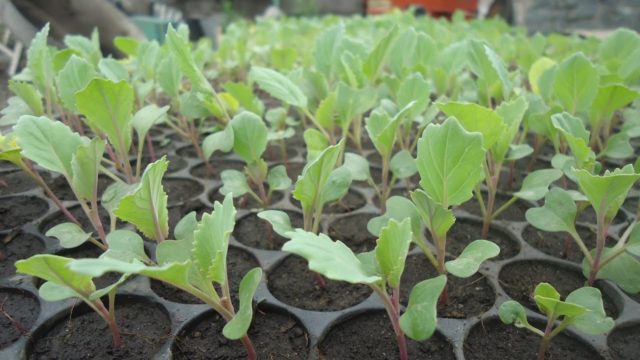
It is better to grow kohlrabi seedlings in containers with separate cells, you can also use disposable plastic cups, cassettes, peat or coconut briquettes
The process starts with preparing the seeds:
- Submerge the material in hot water for 15 minutes. Temperature 50 ° C.
- Immediately transfer seeds to ice water, hold for 1 minute.
- Dip the material into a prepared solution of trace elements for 12 hours.
- Rinse the seeds and put in the refrigerator for a day (vegetable compartment).
- Keep material in a damp cloth until pecking.
After sowing, cover the containers with glass and keep at a temperature of 18-20 ° C. After the emergence of seedlings, shelter is not needed, and the temperature regime is reduced to 8 ° C. After 1.5 weeks, the temperature is raised again to 17-18 ° C.
Taking care of seedlings is easy:
- moistening the earth as needed, do not water it, but "spray" it;
- temperature control;
- single watering of potassium permanganate - the solution must be weak, the measure is needed to prevent black leg;
- when 2 real leaves appear, feed the seedlings - 0.5 tsp for 1 liter of water. mineral complex and 0.5 tablets of microelements.
When sowing in a common box, after the development of 1 true leaf, the seedlings must be moved to peat pots. Then maintain the temperature at 20 ° C. After a few days, reduce it to 17 ° C during the day and 11 ° C at night.
Before planting in open ground, the seedlings must be hardened. The process begins in 2 weeks. This should be done gradually.
How to grow kohlrabi cabbage outdoors
You can plant seeds when the soil is warmed up. To distribute them evenly, you can mix them with another material:
- mustard, millet, rapeseed - pre-calcine the seeds so that they do not germinate in the future;
- sawdust, they must be dry;
- dried sand;
- superphosphate in granules - by weight 3-10 times more than kohlrabi seeds.
It is convenient to plant a crop in open ground with dragee seeds. The seeding rate is less, the distribution is more even, and the emergence of seedlings earlier.
0.1-0.2 g of seeds are sown per 1 m². It is necessary to close them up by 1.5-2.5 cm. It is convenient to sow seeds in the grooves previously spilled with water. Distance between rows 30 cm, between adjacent plants 3-4 cm. Immediately compact the soil.
After emergence, thinning is required. Between neighboring plants, there should be 10-15 cm in early varieties and 25-50 cm in middle and late varieties.
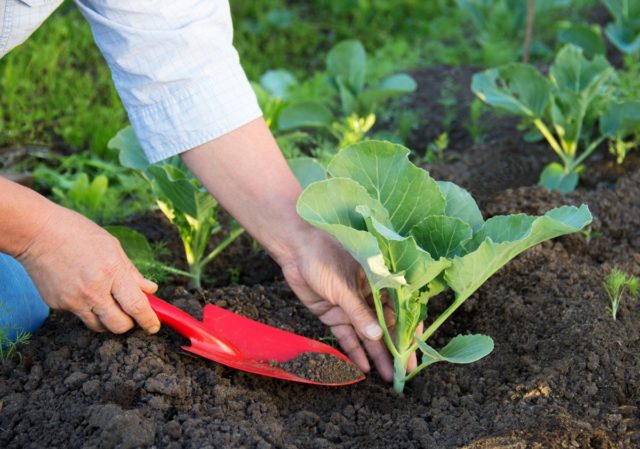
When thinning, the strongest specimens are left in the garden, steel plants can be transplanted to another place
Kohlrabi care rules
To obtain a rich harvest with excellent taste characteristics, kohlrabi agricultural technology in the open field is important. The rules are as follows:
- Make sure that the soil is always moist. At first, kohlrabi is watered once every 2-3 days, then once a week. On hot days, watering should be increased, but not as abundant as for other types of cabbage.
- Weed kohlrabi regularly, loosen the aisles and soil around the plants in the rows, deepen 6-8 cm.The looseness of the soil is important for the juiciness and tenderness of the crop.
- Spud kohlrabi before the start of the growth of the stems.
- You can fertilize the crop 2-3 times per season with a minimum interval of 1 month. An alternation of organic matter and mineral fertilizers is recommended. The culture responds well to Urea, Solution. For 10 liters of water you need 1 tbsp. l. of the selected tool.
Diseases and pests
When grown outdoors, kohlrabi suffers from the same problems as other types of cabbage. One of the common diseases is mucous or vascular (black rot) bacteriosis. The problem can arise at any stage of growth. Disease is promoted by high air temperature and high humidity. For prevention, it is important to observe crop rotation and burning plant residues.
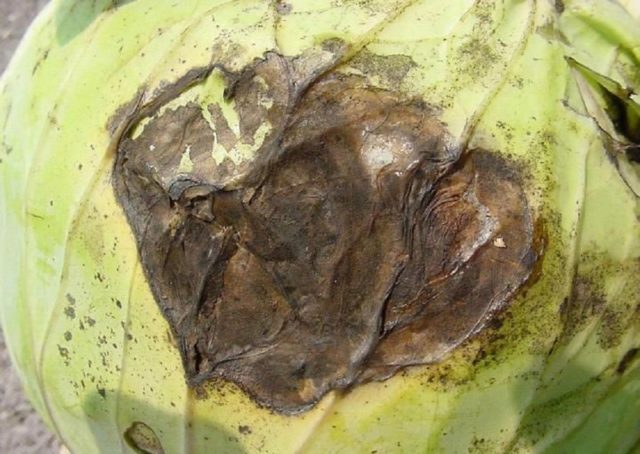
The drug Binoram helps against kohlrabi bacteriosis, seedlings are sprayed with Planriz for prophylaxis
Another fungal disease of kohlrabi is keela. It is facilitated by heavy and acidic soil, its waterlogging. Affected kohlrabi seedlings should be destroyed, in the open field they will die. For prevention, it is necessary to use fumigants for soil cultivation.
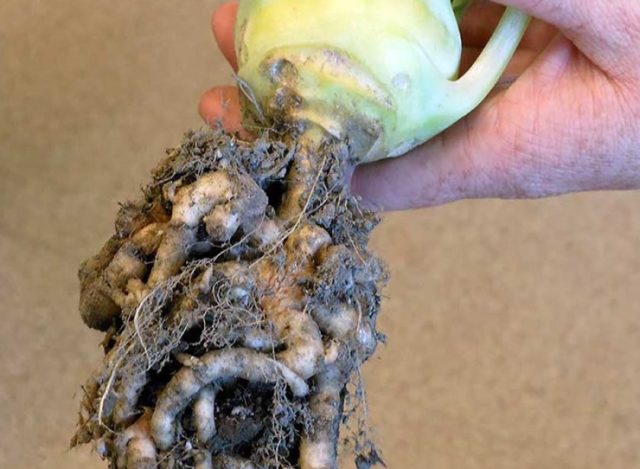
Keela is manifested by swelling and growths on roots that have the same color, the suction ability is impaired, which leads to decay
Another problem with kohlrabi is peronosporosis. Downy mildew often affects seedlings. The disease manifests itself as yellow spots on the leaves above and white bloom below. Yellowing and dying off of the leaf plate begins, the plant weakens.
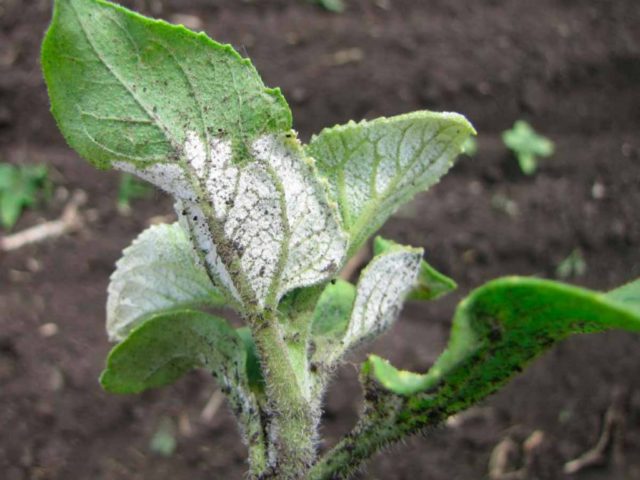
Vectra, Skor, Topaz, Bordeaux liquid help from peronosporosis
Kohlrabi and pests have a lot:
- One of the main parasites is the flea. It can be cruciferous, black, wavy. Pollination with wood ash with slaked lime and ash with tobacco dust will help get rid of insects. You can use naphthalene in row spacings.
The cruciferous flea prefers young growth, appears at a temperature of 15 ° C, the plant can die in 2-4 days
- Another enemy of kohlrabi in the open field is the cruciferous gall midge, also called the petiolate gnat. Its dimensions are only 2 mm. The larvae bring harm. Their defeat leads to deformation of plants, subsequent decay. Early crops are especially affected.
Neonicotinoids help to get rid of the petiole mosquito, for prevention it is important to remove weeds in a timely manner
- The enemy of kohlrabi is also a wireworm - the larvae of any click beetle. They have a rigid body, 1-4.5 cm long. The larvae live in the soil, spoil seeds, young roots, root crops, making them susceptible to various diseases.
Effectively use bait against the wireworm - straw, grass, pieces of root crops, the larvae that climbed there must be collected and destroyed
- Kohlrabi also suffers from tobacco thrips. It usually affects seedlings. You can get rid of the pest with the help of Agravertine, Actellik, Vertimek, Confidor Extra.
To prevent tobacco thrips, it is necessary to burn plant residues, regularly water the plantings, mulch the soil, remove weeds, and dig the soil very deeply
- Another enemy of kohlrabi is cabbage, also called cabbage whitewash. The caterpillars of this butterfly eat the young leaves of the plant. One insect can lay up to 200 eggs.
You can fight cabbage with the drugs Bitoxibacillin, Lepidocide, wasps are a natural enemy
Harvesting
For spring sowing in open ground, kohlrabi must be harvested as it ripens, but it is stored for only 2 weeks in the refrigerator. Summer crops are harvested simultaneously with white cabbage at a temperature of 3-5 ° C during the day and 0-1 ° C at night.
It is necessary to collect kohlrabi on a dry, clear day:
- Dig up the stems with roots.
- Dry the crop in the shade.
- Remove soil and trim leaves. If you leave the roots, then kohlrabi will last longer.
The crop is stored well, but it needs high humidity (95%). The best keeping quality are varieties with a purple peel. It is better to store kohlrabi in boxes, sprinkling the stems with sand. Zero temperature is optimal. If all conditions are met, the harvest can lie up to 8 months.
Conclusion
Growing and caring for kohlrabi outdoors is no more difficult than working with other types of cabbage. The culture can be planted with seeds or seedlings. Care should be comprehensive, including the prevention of diseases and pests. Its correct organization allows you to get a rich harvest with good taste.
